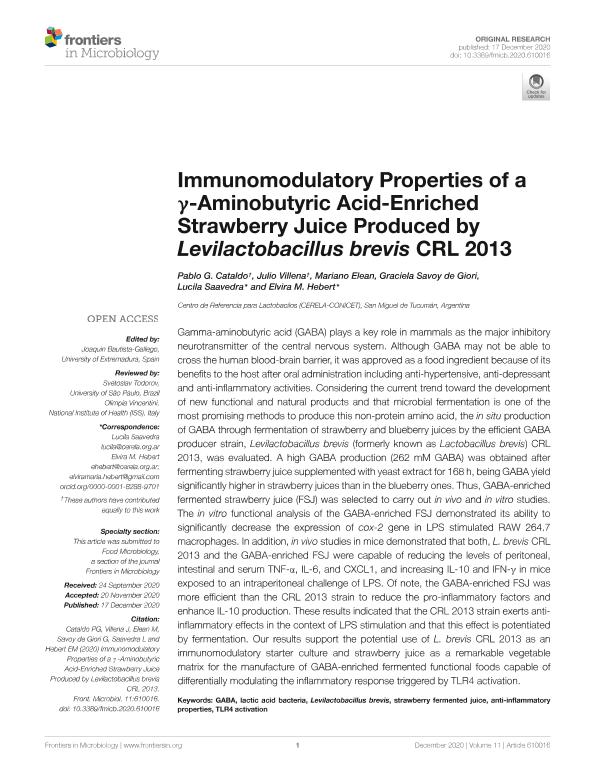Mostrar el registro sencillo del ítem
dc.contributor.author
Cataldo, Pablo Gabriel

dc.contributor.author
Villena, Julio Cesar

dc.contributor.author
Elean, Mariano Daniel

dc.contributor.author
Savoy, Graciela

dc.contributor.author
Saavedra, Maria Lucila

dc.contributor.author
Hebert, Elvira Maria

dc.date.available
2021-05-07T12:42:09Z
dc.date.issued
2020-12
dc.identifier.citation
Cataldo, Pablo Gabriel; Villena, Julio Cesar; Elean, Mariano Daniel; Savoy, Graciela; Saavedra, Maria Lucila; et al.; Immunomodulatory properties of a γ-aminobutyric acid-enriched strawberry juice produced by levilactobacillus brevis CRL 2013; Frontiers Media S.A.; Frontiers in Microbiology; 11; 12-2020; 1-14; 610016
dc.identifier.issn
1664-302X
dc.identifier.uri
http://hdl.handle.net/11336/131644
dc.description.abstract
Gamma-aminobutyric acid (GABA) plays a key role in mammals as the major inhibitory neurotransmitter of the central nervous system. Although GABA may not be able to cross the human blood-brain barrier, it was approved as a food ingredient because of its benefits to the host after oral administration including anti-hypertensive, anti-depressant and anti-inflammatory activities. Considering the current trend toward the development of new functional and natural products and that microbial fermentation is one of the most promising methods to produce this non-protein amino acid, the in situ production of GABA through fermentation of strawberry and blueberry juices by the efficient GABA producer strain, Levilactobacillus brevis (formerly known as Lactobacillus brevis) CRL 2013, was evaluated. A high GABA production (262 mM GABA) was obtained after fermenting strawberry juice supplemented with yeast extract for 168 h, being GABA yield significantly higher in strawberry juices than in the blueberry ones. Thus, GABA-enriched fermented strawberry juice (FSJ) was selected to carry out in vivo and in vitro studies. The in vitro functional analysis of the GABA-enriched FSJ demonstrated its ability to significantly decrease the expression of cox-2 gene in LPS stimulated RAW 264.7 macrophages. In addition, in vivo studies in mice demonstrated that both, L. brevis CRL 2013 and the GABA-enriched FSJ were capable of reducing the levels of peritoneal, intestinal and serum TNF-α, IL-6, and CXCL1, and increasing IL-10 and IFN-γ in mice exposed to an intraperitoneal challenge of LPS. Of note, the GABA-enriched FSJ was more efficient than the CRL 2013 strain to reduce the pro-inflammatory factors and enhance IL-10 production. These results indicated that the CRL 2013 strain exerts anti-inflammatory effects in the context of LPS stimulation and that this effect is potentiated by fermentation. Our results support the potential use of L. brevis CRL 2013 as an immunomodulatory starter culture and strawberry juice as a remarkable vegetable matrix for the manufacture of GABA-enriched fermented functional foods capable of differentially modulating the inflammatory response triggered by TLR4 activation.
dc.format
application/pdf
dc.language.iso
eng
dc.publisher
Frontiers Media S.A.

dc.rights
info:eu-repo/semantics/openAccess
dc.rights.uri
https://creativecommons.org/licenses/by/2.5/ar/
dc.subject
ANTI-INFLAMMATORY PROPERTIES
dc.subject
GABA
dc.subject
LACTIC ACID BACTERIA
dc.subject
LEVILACTOBACILLUS BREVIS
dc.subject
STRAWBERRY FERMENTED JUICE
dc.subject
TLR4 ACTIVATION
dc.subject.classification
Biología Celular, Microbiología

dc.subject.classification
Ciencias Biológicas

dc.subject.classification
CIENCIAS NATURALES Y EXACTAS

dc.title
Immunomodulatory properties of a γ-aminobutyric acid-enriched strawberry juice produced by levilactobacillus brevis CRL 2013
dc.type
info:eu-repo/semantics/article
dc.type
info:ar-repo/semantics/artículo
dc.type
info:eu-repo/semantics/publishedVersion
dc.date.updated
2021-02-10T20:44:24Z
dc.identifier.eissn
1664-302X
dc.journal.volume
11
dc.journal.pagination
1-14; 610016
dc.journal.pais
Suiza

dc.journal.ciudad
Lausana
dc.description.fil
Fil: Cataldo, Pablo Gabriel. Consejo Nacional de Investigaciones Científicas y Técnicas. Centro Científico Tecnológico Conicet - Tucumán. Centro de Referencia para Lactobacilos; Argentina
dc.description.fil
Fil: Villena, Julio Cesar. Consejo Nacional de Investigaciones Científicas y Técnicas. Centro Científico Tecnológico Conicet - Tucumán. Centro de Referencia para Lactobacilos; Argentina
dc.description.fil
Fil: Elean, Mariano Daniel. Consejo Nacional de Investigaciones Científicas y Técnicas. Centro Científico Tecnológico Conicet - Tucumán. Centro de Referencia para Lactobacilos; Argentina
dc.description.fil
Fil: Savoy, Graciela. Consejo Nacional de Investigaciones Científicas y Técnicas. Centro Científico Tecnológico Conicet - Tucumán. Centro de Referencia para Lactobacilos; Argentina
dc.description.fil
Fil: Saavedra, Maria Lucila. Consejo Nacional de Investigaciones Científicas y Técnicas. Centro Científico Tecnológico Conicet - Tucumán. Centro de Referencia para Lactobacilos; Argentina
dc.description.fil
Fil: Hebert, Elvira Maria. Consejo Nacional de Investigaciones Científicas y Técnicas. Centro Científico Tecnológico Conicet - Tucumán. Centro de Referencia para Lactobacilos; Argentina
dc.journal.title
Frontiers in Microbiology
dc.relation.alternativeid
info:eu-repo/semantics/altIdentifier/doi/http://dx.doi.org/10.3389/fmicb.2020.610016
dc.relation.alternativeid
info:eu-repo/semantics/altIdentifier/url/https://www.frontiersin.org/articles/10.3389/fmicb.2020.610016
dc.relation.alternativeid
info:eu-repo/semantics/altIdentifier/url/https://www.ncbi.nlm.nih.gov/pmc/articles/PMC7773669/
Archivos asociados
